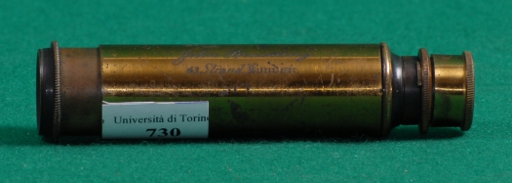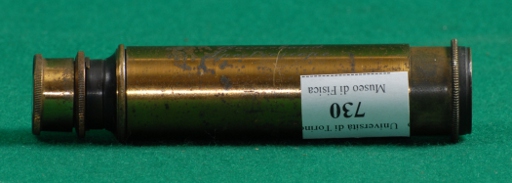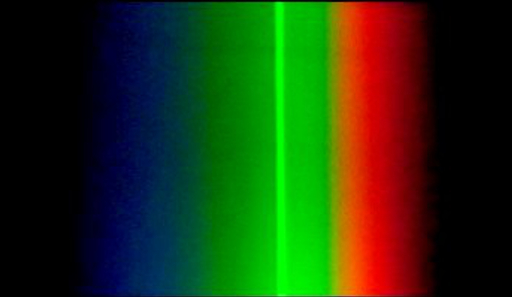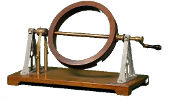» Browning Spectroscope (0730)
Immagini





DESCRIPTION
Exhibit 730 is a portable Browning Spectroscope designed by John Browning (c.1831-1925) in the second half of the 19th century. The user manual written by the inventor is available on the web [1])
The instrument consists of a group CFC of prisms (two crown glasses and one flint glass) fixed in a brass tube that slides inside another brass tube (See design-1) At one end of the tube there is the eyepiece E and the telescope objective OT, while on the other end there is a slit S and a convergent lens CL, that acts as a collimator. In design-1 V..R is a series of images of the slit. See references
[4]) e [5]).
One focuses by sliding the internal tube so that the image of the slit falls in the front focal plane of the collimating lens; then the monochromatic image of the slit, furnished by the prism is formed at infinity and thus on the retina of the observer, focussed at infinity.
[2]
With this instrument one can observe many Fraunhofer lines, the brilliant lines of metals and of gas and the absorption bands in colored gas, in crystals and in liquids. Given that the resolving power (the inverse of the chromatic resolution) of this spectroscope is very small, the spectral lines are close. To obtain high resolution one can use a spectroscope with more prism of the two types.
The spectrum of fluorescent light observed with the Browning spectroscope is shown in [3]).
Another instrument that uses the same principles is exhibit 440.
ISCRIZIONI
- Sul tubo esterno sono stampati il marchio e il nome del costruttore, John Browning
BIBLIOGRAPHY
- [1] URL [ http://www.archive.org/stream/howtoworkwithspe00browrich#page/8/mode/2up ]
- [2] URL [ http://www.museodifisica.it/ITA/htm/strumento.php?id=82 ]
- [3] URL [ http://www.antique-microscopes.com/chemistry/Browning_Direct_Vision_Spectroscope%20.htm ]
- [4] WM. S. FRANKLIN AND BARRY MACNUTT,"LIGHT AND SOUND", MACMILLAN & CO. Ltd. LONDON, 1909. pp. 134-135.
- [5] Edwin Edser, "Light for Students", MACMILLAN & CO. Ltd. LONDON, 1920. pp. 330-360.
Dati Catalografici
| Data di costruzione: | Fine XIX secolo |
|---|---|
| Data di carico: | Ignota |
| Nr. Inventario: | |
| Costruttore: | John Browning |
| Materiale: | ottone, vetro |
| Dimensioni: | Lunghezza: 90 mm; Diametro: 21 mm |
| Conservazione: | buono (L'ottone è macchiato) |
